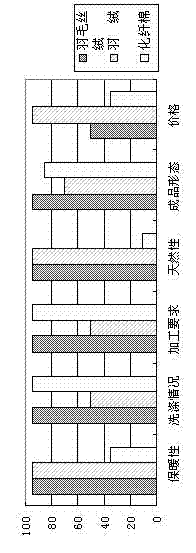Manufacture process for composite heat insulation material
A technology of production process and process steps, which is applied in the field of composite thermal insulation materials, can solve problems such as complex processing technology, difficulty in avoiding chemical pollution, inability to achieve a good thermal insulation effect, etc., to achieve rich raw material resources, rich designs and styles, and market demand Potentially great effect
- Summary
- Abstract
- Description
- Claims
- Application Information
AI Technical Summary
Problems solved by technology
Method used
Image
Examples
Embodiment 1
[0027] 1: After washing, disinfecting, drying, and loosening the feathers mainly of ducks or geese, the feather shafts and feather silks are separated: the feather silks on the feathers are separated from the feather shafts, and the feathers are separated. Silk is collected and feather shaft is removed; Described separation process can take artificial mode or other modes;
[0028] 2: Open the hot-melt fiber and polyester staple fiber separately through the textile opener, and mix the two according to the weight ratio of 16:10;
[0029] 3: Mix the feathers collected after separation with the fibers mixed in the second step. The mixing ratio depends on the content of the feathers required by the finished product, and then mix them evenly with a mixer and remove some impurities, including residual Feather shafts and other non-feather residues, the intermediate product obtained in this step is called feather mixed fiber;
[0030] 4: Spread the above-mentioned feather silk mixed f...
Embodiment 2
[0035] 1: After washing, disinfecting, drying, and loosening the feathers of animal feathers, mainly ducks and geese, the feather shafts and feather silks are separated: the feather silks on the feathers are separated from the feather shafts, The feathers are collected and the feather shafts are removed; the separation process can be done manually or in other ways;
[0036] 2: Open the hot-melt fiber and polyester staple fiber separately through the textile opener, and mix the two according to the weight ratio of 17:12;
[0037] 3: Mix the feathers collected after separation with the fibers mixed in the second step. The mixing ratio depends on the content of the feathers required by the finished product, and then mix them evenly with a mixer and remove some impurities, including residual Feather shafts and other non-feather residues, the intermediate product obtained in this step is called feather mixed fiber;
[0038] 4: Spread the above-mentioned feather silk mixed fiber at...
Embodiment 3
[0043] 1: After washing, disinfecting, drying, and loosening the feathers of animal feathers, mainly ducks and geese, the feather shafts and feather silks are separated: the feather silks on the feathers are separated from the feather shafts, The feathers are collected and the feather shafts are removed; the separation process can be done manually or in other ways;
[0044] 2: Open the hot-melt fiber and polyester staple fiber separately through the textile opener, and mix the two according to the weight ratio of 19:15;
[0045]3: Mix the feathers collected after separation with the fibers mixed in the second step. The mixing ratio depends on the content of the feathers required by the finished product, and then mix them evenly with a mixer and remove some impurities, including residual Feather shafts and other non-feather residues, the intermediate product obtained in this step is called feather mixed fiber;
[0046] 4: Spread the above-mentioned feather silk mixed fiber at ...
PUM
| Property | Measurement | Unit |
|---|---|---|
| thickness | aaaaa | aaaaa |
| thickness | aaaaa | aaaaa |
| melting point | aaaaa | aaaaa |
Abstract
Description
Claims
Application Information
 Login to View More
Login to View More - R&D
- Intellectual Property
- Life Sciences
- Materials
- Tech Scout
- Unparalleled Data Quality
- Higher Quality Content
- 60% Fewer Hallucinations
Browse by: Latest US Patents, China's latest patents, Technical Efficacy Thesaurus, Application Domain, Technology Topic, Popular Technical Reports.
© 2025 PatSnap. All rights reserved.Legal|Privacy policy|Modern Slavery Act Transparency Statement|Sitemap|About US| Contact US: help@patsnap.com


